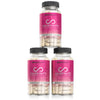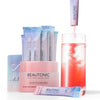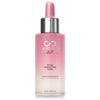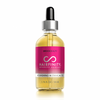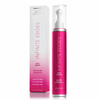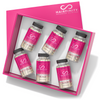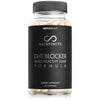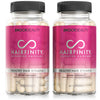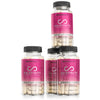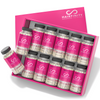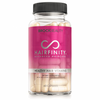
Natural Alternatives to Hair Dye

Whether you’re looking to cover up your gray or sport a whole new look, dyeing your hair usually means spending hours in the salon with harsh chemicals.
Not only will hair dye do a number on your hair – stripping the shaft of its strength and moisture – but the number of chemicals in a single application could add up to more damage over time.
We decided to investigate the benefits of natural hair dyes – and which chemicals you should keep an eye out for if you head to the salon:
Why Go Natural?
For women who want to eliminate their gray hair, regular appointments with a colorist are a way of life. But what if dye actually puts you in the path of all sorts of scary health risks?
According to the Environmental Working Group, one of the most trusted independent research groups in the beauty industry, many conventional hair dyes do contain harmful chemicals.
In fact, the EWP “found that 69% of hair-dye products they tested for their Skin Deep database may pose cancer risks,” reports Alexandra Zissu at Good Housekeeping.
Currently, their database has almost 1,000 products devoted to hair coloring, with brands ranging from L’Oréal Paris to Revlon.
It’s a super comprehensive list that can help keep you informed, should you decide to purchase boxed dye.
So, you’re committed to dyeing your hair, and you’re thinking of using a natural dye – great! But what will dyeing your hair actually do to the overall health of your locks?
Because hair dye works by coloring the hair shaft, colorists use ammonia to help remove the protective layer of the cuticle. The dye will only set once your original color is treated.
“In order to get the color that you wanted, your current color has to be destroyed,” stylist Ni’Kita Wilson explains to Huffington Post. “That’s where the peroxide comes in, and that breaks down your natural hair pigment.”

But this process makes your hair weaker and more vulnerable to breakage – especially right after the dye is applied.
If you’ve noticed a change in texture or volume after regular dyeing, it’s time to up your conditioning game.
Make sure you’re using a gentle shampoo that won’t strip moisture further from your hair, and schedule some extra shower time to accommodate weekly deep conditioning treatments.
“Look for a mask with moisturizing and repairing ingredients (like shea butter, glycerin, and keratin), and use it from midlength to ends once a week,” advise the editors at Oprah Magazine.
Of all the complaints leveled at natural hair dyes, inconsistent color or lack of staying power seem to be the most common.
“People report turning orange as carrots (with real henna), or very inconsistent results, even with the same product, over time,” writes Zissu at Good Housekeeping.
“These colors don’t last very long, either. But that’s par for the course with a more natural dye, as it doesn’t penetrate the hair shaft like a synthetic does.”
While it’s true that manufactured hair dyes are generally preferred by colorists because they work more efficiently and effectively than natural dyes, you still run the risk of encountering some pretty nasty chemicals if you decide to dye the old-fashioned way.
If you’re on the hunt for a new colorist – or you just buy boxed color at the store – here are the primary offenders to keep an eye out for:
PPDs: When PPDs react with hydrogen peroxide to help bind hair color to the hair shaft, it can unleash the potential for cell mutation – and that spells increased cancer risk.
Lead acetate: A heavy metal contaminant linked to cancer and toxicity.
Resorcinol: Usually used to help achieve a specific dye color. When resorcinol reacts with the dye developer, it can irritate skin.
Walk on the Wild Side
Ready to embrace a chemical-free color treatment? There are a few different ways to go.
If you want to commit full-stop, then look for natural ingredients like henna and vegetable-based dyes.
Because of its color, henna is best for true redheads and brunettes; it makes a great base ingredient for natural or organic boxed dyes, too.
“Natural henna, on its own, creates a red-orange color, so if you see products offering other colors produced with henna, realize the manufacturers have mixed the henna with other ingredients to achieve those colors,” advise the editors at Annmarie skin care.
Most salons won’t offer dye sessions with natural ingredients like henna or vegetable-based dyes, however, so you’ll have to be comfortable tackling a DIY dye job.
You can always invite a friend over and make a spa day of it – not a bad way to spend an afternoon, if we do say so.
For those of you who might want a more professional experience – we hear you. While salons that don’t use ammonia or other harsh products are harder to come by, they do exist, and their owners are passionate about the products they use.
When you call to book your appointment, ask if your stylist uses “ammonia-free, herbal-based, low-PPD, and dyes that are also lead-, toluene- and coal tar-free,” suggests Zissu.
Finally, if you’re not opposed to using some chemical treatments, there are always ammonia-free boxed dyes available at major retailers.
Zissu recommends the brands Herbatint, Light Mountain, and Surya Henna, amongst others, since they don’t use harsh chemicals.
Say goodbye to painful burning or other uncomfortable sensations, and get ready for soft, naturally dyed hair.

Protecting Your Hair & Scalp
Even if you’re making the switch to natural dyes, coloring treatments can be pretty traumatic for your hair.
“Hair always gets a little damaged when applying color, even if you’re going back to your natural hue,” write the editors of InStyle.
“Both permanent and semi-permanent dyes contain hydrogen peroxide, which chemically changes the color of the hair pigment,” they add.
Even Herbatint, a British company that sells ammonia-free, vegan hair color, uses hydrogen peroxide in its primary hair color line.
They also offer a temporary dye line called Vegetal that uses no peroxide or PPDs. Essentially Vegetal works by introducing highlights and lowlights into your hair.
Rather than dramatically changing your hair color, this safer, temporary dye alters the tint or shade of your existing color.

Asking your stylist for highlights and lowlights is a great alternative to dyeing your hair, suggests Zissu, because “they don’t place dye in contact with the scalp.”
Not only are these techniques safer than dyeing your hair, but they’ll also protect your hair from all-out damage, especially if you stock up on an all-natural hue.
If you plan on dyeing your hair regularly, it’s really important to commit to a haircare routine that will bring moisture and vitality back to your locks. Otherwise, you could be stuck with a dry, dull, lifeless look.
One of the first things to add to your routine is a sulfate-free shampoo, or a shampoo that has fewer surfactants – the ingredients that make shampoo foam and bubble.
“When it comes to your typical lathering shampoo, you get a squeaky clean feel because you’ve removed all the oils,” hairstylist Mara Roszak explained to Elle.
The more you strip those natural oils from your scalp, the harder it becomes for your hair to bounce back from harsh dye treatments.
Keeping your shower temps low, avoiding heated styling tools, and making time for conditioning treatments will all make a big difference, too.
After all, what’s the point of a fancy new ‘do, if it doesn’t help you look – and feel – healthy, happy, and gorgeous?
With a little bit of planning – and doing your homework when it comes to hair color ingredients – you can help your hair bounce back from a dye job faster than ever.
While finding a salon that offers ammonia- and hydrogen peroxide-free coloring treatments might be difficult, it’s not impossible.
Plus, many of the less toxic brands of hair color – once out of reach and sold overseas – are now easily accessible via the Internet. (Thanks, Google!)
Of course, if you want to be super subversive, you could always embrace your gray as it comes in – and wear your new color with pride.





